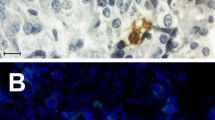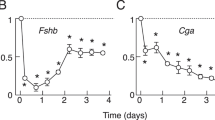Abstract
The thyrotropin- (TRH) releasing hormone precursor (26 kDa) undergoes proteolytic cleavage at either of two sites, generating N-terminal 15 kDa/9.5 kDa or C-terminal 16.5/10 kDa intermediate forms that are processed further to yield five copies of TRH-Gly and seven non-TRH peptides. Glucocorticoids (Gcc) have been shown to enhance TRH gene expression in three different cell systems in vitro, an effect that occurs, at least in part, through transcriptional activation. Although this implies that an increase of TRH prohormone biosynthesis would take place, this had not been demonstrated as yet. We report here that the synthetic glucocorticoid dexamethasone (Dex) substantially elevated the de novo biosynthesis of the intact 26-kDa TRH prohormone and its intermediate products of processing in cultured anterior pituitary cells, an observation that is consistent with an overall upregulation of both the biosynthesis and degradation of the TRH precursor. We reasoned that Gcc may act not only at the transcriptional, but also at the translational/posttranslational level. To address this question we chose a different cell system, AtT20 cells transfected with a cDNA encoding preproTRH. Since TRH gene expression in these cells is driven by the CMV-IE promoter and not by an endogenous “physiological” promoter, these cells provide an ideal model to study selectively the effects of Gcc on the translation and posttranslational processing of proTRH without interference from a direct transcriptional activation of the TRH gene. Dex caused a significant 75.7% increase in newly synthesized 26-kDa TRH prohormone, suggesting that the glucocorticoid raised the translation rate. We then demonstrated that Dex treatment accelerated TRH precursor processing. Of interest, processing of the N- vs the C-terminal intermediate was influenced differentially by the glucocorticoid. Although the N-terminal intermediate product of processing accumulated, the C-terminal intermediate was degraded more rapidly. Consistent with these observations was the finding that the intracellular accumulation of the N-terminally derived peptide preproTRH25–50 was enhanced, but levels of the C-terminally derived peptide preproTRH208–255 were reduced. Accumulation of TRH itself, whose five copies are N- and C-terminally derived, was also enhanced.
We conclude that Gcc induce changes in the biosynthesis and processing of proTRH by increasing the translation rate and by differentially influencing the processing of N- vs C-terminal intermediates of the precursor molecule. These effects of Gcc at the translational and posttranslational levels result in an increase in TRH production accompanied by differential effects on the accumulation of N- and C-terminal non-TRH peptides.
Similar content being viewed by others
References
Lechan, R. M., Wu, P., Jackson, I. M. D., et al. (1986). Science 231, 159–161.
Jackson, I. M. D. (1994). In: The Pituitary Gland, 2nd ed., Imura, H., ed., Raven: New York, pp. 179–216.
Bowers, C. Y., Friesen, H. G., Hwang, P., Guyda, H. J., and Folkers, K. (1971). Biochem. Biophys. Res. Commun. 45, 1033–1041.
Wilber, J. F. and Utiger, R. D. (1967). Proc. Soc. Exp. Biol. Med. 127, 488–490.
Takahara, J., Arimura, A., and Schally, A. V. (1974). Proc. Soc. Exp. Biol. Med. 146, 831–835.
Lechan, R. M. (1993). Thyroid Today 16, 1–11.
Metcalf, G. (1974). Nature 252, 310–311.
Hedner, J., Hedner, T., Jonason, J., and Lundberg, D. (1981). Neurosci. Lett. 24, 317–320.
Sevarino, K. A., Goodman, R. H., Spiess, J., Jackson, I. M., and Wu, P. (1989). J. Biol. Chem. 264, 21,529–21,535.
Nillni, E. A., Sevarino, K. A., and Jackson, I. M. D. (1993). Endocrinology 132, 1260–1270.
Perez de la Cruz, I. and Nillni, E. A. (1996). J. Biol. Chem. 271, 22,736–22,745.
Schaner, P., Todd, R. B., Seidah, N. G., and Nillni, E. A. (1997). J. Biol. Chem. 272, 19,958–19,968.
Beato, M. (1989). Cell 56, 335–344.
Yamamoto, K. R. (1985). Annu. Rev. Genet. 19, 209–252.
O’Malley, B. (1990). Mol. Endocrinol. 4, 364–369.
Wahli, W. and Martinez, E. (1991). FASEB J. 5, 2243–2249.
Barg, J., Rius, R. A., Bem, W. T., Belcheva, M. M., Loh, Y. P., and Coscia, C. J. (1992). Brain Res. Dev. Brain Res. 66, 71–76.
Birnberg, N. C., Lissitzky, J. C., Hinman, M., and Herbert E. (1983). Proc. Natl. Acad. Sci. USA 80, 6982–6986.
Deschepper, C. F. and Flaxman, M. (1990). Endocrinology 126, 963–970.
Kovacs, K. J. and Mezey, E. (1987). Neuroendocrinology 46, 365–368.
Thiele, E. A., Marek, K. L., and Eipper, B. A. (1989). Endocrinology 125, 2279–2288.
Fuller, P. J. (1991). FASEB J. 5, 3092–3099.
Diamond, M. I., Miner, J. N., Yoshinage, S. K., and Yamamoto, K. R. (1990). Science 249, 1266–1272.
Schule, R., Rangarajan, P., Kliewer, S., et al. (1990). Cell 62, 1217–1226.
de Nadai, F., Rovere, C., Bidard, J. N., et al. (1993). Endocrinology 132, 1614–1620.
Firestone, G. L., Payvar, F., and Yamamoto, K. R. (1982). Nature 300, 221–225.
Goodman, L. J. and Firestone, G. L. (1993). Mol. Endocrinol. 7, 94–103.
Haffar, O. K., Aponte, G. W., Bravo, D. A., John, N. J., Hess, R. T., and Firestone, G. L. (1988). J. Cell Biol. 106, 1463–1474.
Poyet, P., Henning, S. J., and Rosen, J. M. (1989). Mol. Endocrinol. 3, 1961–1968.
Shields, P. P., Dixon, J. E., and Glembotski, C. C. (1988). J. Biol. Chem. 263, 12,619–12,628.
Corey, J. L. and Stallcup, M. R. (1992). Mol. Endocrinol. 6, 450–458.
Kain, S. R., Jen, T. I., and Firestone, G. L. (1993). J. Biol. Chem. 268, 19,640–19,649.
Platt, E. J., Goodman, L. J., Kain, S. R., Zettl, K. S., and Firestone, G. L. (1991). Mol. Endocrinol. 5, 1696–1706.
Luo, L., Bruhn, T. O., and Jackson, I. M. D. (1995). Endocrinology 136, 4945–4950.
Bruhn, T. O., Rondeel, J. M., Bolduc, T. H., and Jackson, I. M. D. (1994). Endocrinology 134, 821–825.
Tavianini, M. A., Gnokos, P. J., Lampe, T. H., and Ross, B. A. (1989). Mol. Endocrinol. 3, 605–610.
Bruhn, T. O., Bolduc, T. G., MacLean, D. B., and Jackson, I. M. D. (1991). Endocrinology 129, 556–558.
Bruhn, T. O., Rondeel, J. M. M., Bolduc, T. G., and Jackson, I. M. D. (1994). Endocrinology 134, 815–820.
Nillni, E. A., Sevarino, K. A., Wu, P., and Jackson, I. M. D. (1991). In: Methods in Neurosciences. Neuropeptide Technology, vol. 6., Conn, P. M., ed., Academic: New York, pp. 51–69.
Chomczynski, P. and Sacchi, N. (1987). Anal. Biochem. 162, 156–159.
Selden, R. (1987). In: Current Protocols in Molecular Biology, Janssen, K., ed., Wiley: New York, pp. 4.9.1–4.9.7.
Nillni, E. A., Friedman, T. C., Todd, R. B., Birch, N. P., Loh, Y. P., and Jackson, I. M. D. (1995). J. Neurochem. 65, 2462–2472.
Schagger, H. and Von Jagow, G. (1987). Annal. Biochem. 166, 368–379.
Nillni, E. A., Luo, L. G., Jackson, I. M. D., and McMillan, P. (1996). Endocrinology 137, 5651–5661.
Kakucska, I., Qi, Y., and Lechan, R. M. (1995). Endocrinology 136, 2795–2802.
Cintra, A., Fuxe, K., Wilkstrom, A. C., Visser, T., and Gustafsson, J. A. (1990). Brain Res. 506, 139–141.
Lee, S. L., Stewart, K., and Goodman, R. H. (1988). J. Biol. Chem. 263, 16,604–16,609.
Lee, S. L. and Sevarino, K. A. (1991). Methods Neurosci. 5, 34–44.
Friedman, T. C., Loh, Y. P., Huang, S. S., Jackson, I. M. D., and Nillni, E. A. (1995). Endocrinology 136, 4462–4472.
Nillni, E. A., Sevarino, K. A., and Jackson, I. M. D. (1993). Endocrinology 132, 1271–1277.
Bloomquist, B. T., Eipper, B. A., and Mains, R. E. (1991). Mol. Endocrinol. 5, 2014–2024.
Day, R., Schafer, M. K.-H., Watson, S. J., Chretien, M., and Seidah, N. G. (1992). Mol. Endocrinol. 6, 485–497.
Nillni, E. A., Verdier, P. A., and Huang, S. H. (1995). Mol. Biol. Cell. 6(Abstract 1926), 331a.
Author information
Authors and Affiliations
Rights and permissions
About this article
Cite this article
Bruhn, T.O., Huang, S.S., Vaslet, C. et al. Glucocorticoids modulate the biosynthesis and processing of proThyrotropin releasing-hormone (proTRH). Endocr 9, 143–152 (1998). https://doi.org/10.1385/ENDO:9:2:143
Received:
Revised:
Accepted:
Issue Date:
DOI: https://doi.org/10.1385/ENDO:9:2:143




